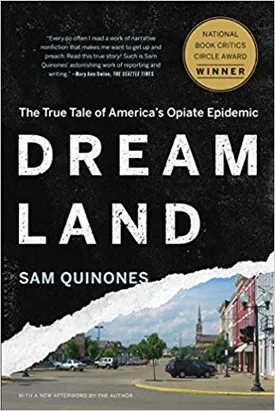Dreamland: The True Tale of America’s Opiate Epidemic by Sam Quinones
The opioid epidemic has been ravaging communities and families across the United States for some time, leaving devoted friends and colleagues in its wake and casting a ghostly light over the future of America. The same could be said of Sam Quinones’s 2015 work “Dreamland: the True Tale of America’s Opiate Epidemic.”
Dreamland delves into the heartbreaking story of the opioid epidemic in America. Quinones examines the social and economic inequity that has been widespread in the United States for decades and shows how both parties, whether it be big pharma or Mexican drug cartels, have profited from an awfully costly industry.
Dreamland puts a human face to the tragedies surrounding the epidemic, and Quinones demonstrates his immense compassion in each of the stories he tells. Take, for example, the story of an addict by the name of Tony. Tony was already addicted to opiates and drove along with a group of other users to the small town of Portsmouth, Ohio, searching desperately for OxyContin. He soon meets a vivacious woman named Susie, whom Tony is instantly drawn to. She gives Tony his very first taste of OxyContin, leading him down an incredibly destructive path.
At the same time, Quinones traces the development of an industry around the opioid crisis, one that has made it startlingly easy to perpetuate the epidemic. The book traces the rise of the pharmaceutical industry, who pioneered the prescription of “hillbilly heroin” (as Quinones refers to OxyContin). The work of Purdue Pharma, a pharmaceutical company that sold OxyContin, is often credited as the spark that started raging wildfire of the opioid crisis and Quinones speaks frankly about the company’s negligence and immoral profiteering.
Quinones also delves into the background of the Mexican black market for drugs, demonstrating that the opioid epidemic is far from a singularly American problem, and this is particularly illustrated through the rise of traffickers from Xalisco, a small town in Mexico. Quinones goes on to explain that in order to get a hold of the drugs, addicts had to develop a difficult, yet tenuous relationship with the dealers, one full of risk and manipulation, and the dealers soon become “gatekeepers of a world.”
Dreamland proves to be an incredibly troubling read. As Quinones notes, “An epidemic is not caused by isolated events or episodes, but by a slowly accumulating mélange of elements—culture, government policy, pharmaceutical industry practices, medical decisions, and individual choices—weaving together into a patterns so much larger than its individual parts.” It is a book that speaks to something larger, something beyond individual tragedy and suffering, and demonstrates just why the opioid crisis has been such a widespread and fatal event in America.
At the end of the day, Dreamland does a tremendous job of shedding light on the issues surrounding the opioid crisis and doing justice to the victims and families of this horrific event. It is a must-read for anyone who wants to better understand the reality of today’s opiate epidemic, and the desperately need for reform that goes with it.

